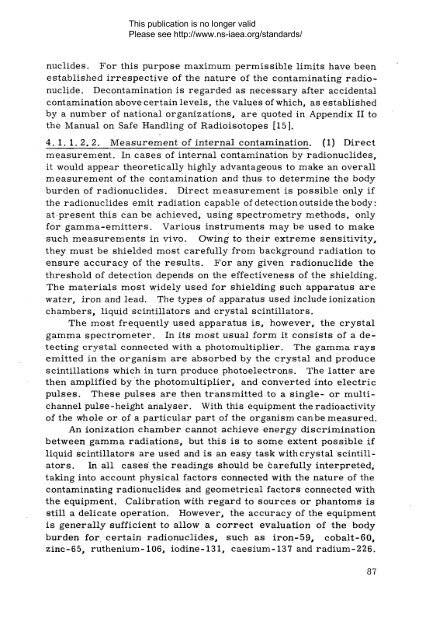Safety_Series_025_1968 - gnssn - International Atomic Energy ...
Safety_Series_025_1968 - gnssn - International Atomic Energy ...
Safety_Series_025_1968 - gnssn - International Atomic Energy ...
You also want an ePaper? Increase the reach of your titles
YUMPU automatically turns print PDFs into web optimized ePapers that Google loves.
This publication is no longer validPlease see http://www.ns-iaea.org/standards/nuclides. For this purpose maximum permissible limits have beenestablished irrespective of the nature of the contaminating radionuclide.Decontamination is regarded as necessary after accidentalcontamination above certain levels, the values of which, as establishedby a number of national organizations, are quoted in Appendix II tothe Manual on Safe Handling of Radioisotopes [15].4. 1. 1. 2. 2. Measurement of internal contamination. (1) Directmeasurement. In cases of internal contamination by radionuclides,it would appear theoretically highly advantageous to make an overallmeasurement of the contamination and thus to determine the bodyburden of radionuclides. Direct measurement is possible only ifthe radionuclides emit radiation capable of detection outside the body:at present this can be achieved, using spectrometry methods, onlyfor gamma-emitters. Various instruments may be used to makesuch measurements in vivo. Owing to their extreme sensitivity,they must be shielded most carefully from background radiation toensure accuracy of the results. For any given radionuclide thethreshold of detection depends on the effectiveness of the shielding.The materials most widely used for shielding such apparatus arewater, iron and lead. The types of apparatus used include ionizationchambers, liquid scintillators and crystal scintillators.The most frequently used apparatus is, however, the crystalgamma spectrometer. In its most usual form it consists of a detectingcrystal connected with a photomultiplier. The gamma raysemitted in the organism are absorbed by the crystal and producescintillations which in turn produce photoelectrons. The latter arethen amplified by the photomultiplier, and converted into electricpulses. These pulses are then transmitted to a single- or multichannelpulse-height analyser. With this equipment the radioactivityof the whole or of a particular part of the organism can be measured.An ionization chamber cannot achieve energy discriminationbetween gamma radiations, but this is to some extent possible ifliquid scintillators are used and is an easy task with crystal scintillators.In all cases the readings should be carefully interpreted,taking into account physical factors connected with the nature of thecontaminating radionuclides and geometrical factors connected withthe equipment. Calibration with regard to sources or phantoms isstill a delicate operation. However, the accuracy of the equipmentis generally sufficient to allow a correct evaluation of the bodyburden for certain radionuclides, such as iron-59, cobalt-60,zinc-65, ruthenium-106, iodine-131, caesium-137 and radium-226.87
















